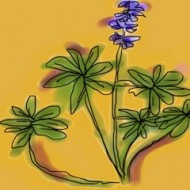The Dry Garden: On sage and size
MANY gardens go without sage in California but at the cost of soul. Sage is to the West what lavender is to France.
Sage, or in botanical terms salvia, has it all: Its pungent aromas contain the signature scent of the Western chaparral. The silvers, grays and greens of its foliage anchor the local Craftsman color wheel, and the long-running show of flowers come in a spectrum of white to pink to mauve to scarlet to purple to indigo to sky blue.
Many sages have long had medicinal and culinary applications, but for modern Californians it’s a balm to the eyes. A felt-like quality to the foliage, combined with a loose-branching habit, allows sage to diffuse the harshest midday sunshine rather than reflect it. Sages do not need fertilizer, and in fact they shrivel at the suggestion. Few other plants …
The Dry Garden: Harvesting rain
IT STANDS to reason that some of the most progressive environmentalists in Los Angeles work for the Department of Public Works’ Bureau of Sanitation. They are the front line between what we discard and the environment.
Last week we looked at their fight to triage our system for recycling food scraps. This week the subject is their battle to capture rainfall before it enters L.A.’s massive storm drain system.
The bureau, along with a leading Southland water agency, the state Legislature and environmental nonprofit groups such as TreePeople and the Green LA Coalition are all moving to make harvesting rainwater as routine as recycling. To keep reading The Dry Garden column in the Los Angeles Times, click here.
For the agenda of a November 13, 2009 public meeting on the draft Low Impact Development ordinance due to go before the City Council soon, click here.
From …
Los Alamos legacy
FRANK CLIFFORD, author of “The Backbone of the World,” long-time staff environment editor of the Los Angeles Times and now a freelance writer based in Santa Fe, New Mexico, reports in today’s Los Angeles Times on a threat from the Los Alamos National Laboratory to the Rio Grande. From the story:
Isolated on a high plateau, the Los Alamos National Laboratory seemed an ideal place to store a bomb factory’s deadly debris. But the heavily fractured mountains haven’t contained the waste, some of which has trickled down hundreds of feet to the edge of the Rio Grande, one of the most important water sources in the Southwest. Click here to keep reading.…
The Dry Garden: ‘American Meadow’
CALIFORNIA nurseryman John Greenlee has a new book, “The American Meadow Garden: Creating a Natural Alternative to the Traditional Lawn.”
Yay?
It should be yay. In 1987, he created what is now the oldest specialty grass nursery on the West Coast. Greenlee Nursery, first in Pomona and now in Chino, is where artist Robert Irwin went when landscaping the grounds of the Getty Center. During the last 22 years, as a nurseryman, garden designer and writer, Greenlee has emerged as the single most recognizable voice of the Western anti-lawn movement.
Click here to keep reading this week’s Dry Garden column in the Los Angeles Times.…
The Dry Garden: Weeding in the rain
With the first rain of the season fast evaporating from the tree leaves outside the window, it feels as if I may never again enjoy perfect gloom. So much rain in Los Angeles fails to come at all; other times it comes down too hard, and so often it falls at night. By contrast, this week water met daylight. From morning till night, the atmosphere was like gray milk, making visibility down among the plants incomparably good. Without its normal cover of glare, the garden stood for inspection … By Wednesday afternoon, it was time to admit a knuckle-scraping truth. The job that needed doing was weeding.
To keep reading the Dry Garden in the Los Angeles Times, click here.…
« go back — keep looking »

